How To Create Joined Report In Salesforce

Salesforce is a robust database system that accommodates a variety of interesting features. For data management and analysis major brands vouch for some features that you can access via Salesforce. Salesforce reports are quite the rage but how to go about them might seem like a task! This article deals with different options for effective reporting and putting the dashboard feature to good use. Read along to understand these features better.
Here's a snapshot of what you will be looking at:
- What is a Report?
- Types of Reports in Salesforce
- Summary
- Matrix
- Tabular
- Joined Reports
- Creating a Report in Salesforce
- Filters
- Fields
- Preview
- What is a Dashboard?
- Creating a Dashboard in Salesforce
- Conclusion
What is a Report?
A report is defined as a document that contains data in an organized graphical or tabular format. Salesforce enables you to create different types of reports to be able to analyze and understand your data better. You can create Standard reports to cover all the basic requirements or perhaps rely on custom report types to make your analysis. There are Opportunity reports that can help you to access Opportunity records and fields within your report.
Types of Reports in Salesforce
Here are the different types of Salesforce reports you can use:
- Summary
- Matrix
- Tabular
- Joined Reports
Summary
Summary Reports are utilized to group rows of data. The "Group Field" plays an integral role in Summary Reports. Grouping is done on the basis of the value of a selected field. Suppose if a property object has a custom field "Status" of picklist type and has two values (Sold, Available). Then, by selecting the status field as a grouping field, a summary report can be generated in two groups, a 'Sold' group, and an 'Available' group.
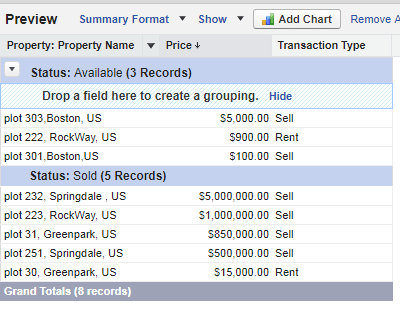
Matrix
Matrix Report bears a lot of similarities to the Summary Report. In the Summary Report, the grouping is done on the basis of rows, whereas in Matrix Report there is a need for grouping based on columns and rows. Here is an example of Matrix Report:
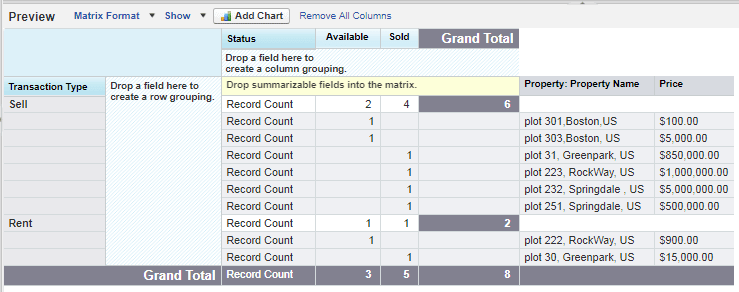
Tabular
This is the simplest Salesforce Report which displays records in a tabular format. The following image depicts all the Property records in a row by row tabular format:
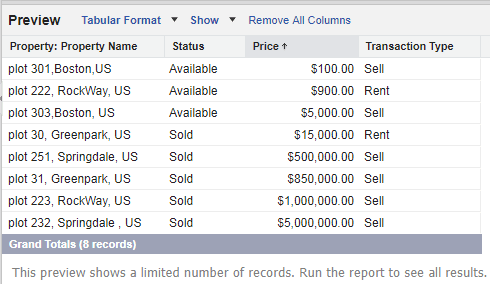
Joined Reports
You can use Joined Reports to compare and represent the data of one or more objects in a single report. Here is an example of Joined Report in Salesforce:
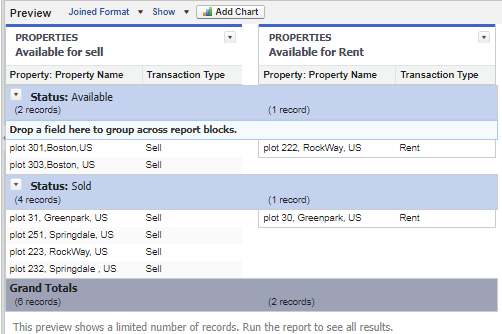
Hevo offers a faster way to move data from databases or SaaS applications like Salesforce into your data warehouse to be visualized in a BI tool for free. Hevo is fully automated and hence does not require you to code.
Hevo is a no-code platform that can be used in collaboration with a number of database options for automation and manageability. Just with an initial easy setup you can keep a tab on running features of Salesforce and various other databases with ease.
Get Started with Hevo for Free
Check out some of the cool features of Hevo:
- Completely Automated: The Hevo platform can be set up in just a few minutes and requires minimal maintenance.
- Real-time Data Transfer: Hevo provides real-time data migration, so you can have analysis-ready data always.
- 100% Complete & Accurate Data Transfer: Hevo's robust infrastructure ensures reliable data transfer with zero data loss.
- Scalable Infrastructure: Hevo has in-built integrations for 100+ sources(Including 30+ Free Sources like Salesforce) that can help you scale your data infrastructure as required.
- 24/7 Live Support: The Hevo team is available round the clock to extend exceptional support to you through chat, email, and support call.
- Schema Management: Hevo takes away the tedious task of schema management & automatically detects the schema of incoming data and maps it to the destination schema.
- Live Monitoring: Hevo allows you to monitor the data flow so you can check where your data is at a particular point in time.
Sign up here for a 14-Day Free Trial!
Creating a Report in Salesforce
It is quite simple to get started with creating reports for valuable business insights into your data. You can select the type of report depending upon the fields and records you want to highlight when you create the report. Reports display on the records that satisfy the criteria mentioned in the report type. This can help to create an analysis mechanism for specific fields and records amidst the business data. You can, thus, analyze any number of combinations and view them in easy to understand formats that can be shared with others. The Report Builder offers some additional drag-and-drop features which you can use to further add into existing reports or perhaps to create new ones from scratch.
Follow these simple steps to create a report in Salesforce:
- To create a simple tabular report, select the Reports tab under the Suggestion Box icon.
- Click on New Report.
- The report type can be then chosen by expanding the Suggestions box. Choose Edit, "Allow Reports" and then Save these settings to create the report.
- Click on Continue.
- You can observe the ongoing records and Suggestion Name Field activated in the Report Builder.
- Go to Add Columns and Select Status.
- Enter the "Number of Days Open" in the Column Search.
- Click on "Save".
- Proceed to name your report.
- Select the appropriate Folder and set to "Public Reports" for public accessibility.
- Click on Save.
- "Save & Run" to finish creating the report.
Image source: https://trailhead.salesforce.com/en/content/learn/projects/suggestion_box/suggestion_box_5
- You can also choose to create a Summary report for added insights.
- In the Report Results view proceed to Suggestions > Edit >Save As.
- Type "By Status" in the report name.
- Choose the Public Reports Folder. Select Save and Edit.
- Under the Groups Search column, select Status.
- Click on Save. "Save & Run".
- You can then click the Add Chart button to add a chart to the report.
- Once you finish adding all summary pointers, click Save and your report is good to go!
Image source: https://trailhead.salesforce.com/en/content/learn/projects/suggestion_box/suggestion_box_5
Here are the three different components of a Salesforce Report:
- Filters
- Fields
- Preview
Filters
Filters can be used to filter the reports to show only the required data. Say, the requirement is to get a report on sold properties. Then, click on Add Filter and select the 'Status' field and choose the value 'Sold' as shown below, and click on 'OK'.

Fields
This refers to all the fields related to the 'Property' object. There are a few buttons right to the 'Fields' label which are used to group fields. You can also search for a specific field in the quick find box. You can easily drag and drop the fields to the preview page you want to report on.
Preview
Suppose you chose the four fields: Status, Property Name, Price, and Transaction Type, then the preview for the report is shown as below:
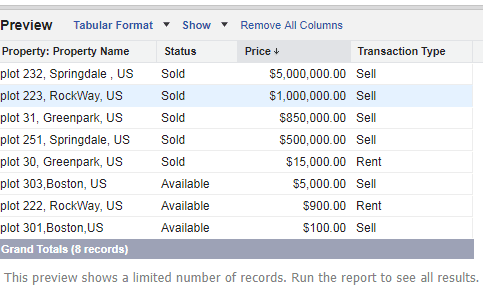
What is a Dashboard?
A dashboard in Salesforce can be used to collect different data sources and visuals to present and analyze them as tables, charts and metrics as suited for your specific purpose. These provide a quick snapshot of the main performance metrics and growth indicators for your company or organization.
Such tools can be greatly significant when trying to discover and understand different parameters of growth for your business. A number of database tools allow the easy storage and transfer of data but this data remains truly valuable only when a proper analysis can be carried out to facilitate better understanding of certain parameters essential for growth. Salesforce Reports and Dashboards serve exactly that purpose in being able to highlight trends and patterns from the pre-existing data points.
Creating a Dashboard in Salesforce
A Salesforce Dashboard setup lets you formulate an appeasing collection of the important business data as charts tables and metrics for analysis. Multiple or singular dashboard components can be integrated to create an impactful visual representation of essential data points. Necessary access specifications can also be assigned to these dashboards for monitored viewership. At times businesses might discover the need for an easy representation of frequent changes to indicative data points. You can also render dynamic dashboards which can accommodate the real-time changes updated via the running user.
You can create a Dashboard by following these steps:
- Under the Dashboards tab, select New Dashboard.
- Give a Dashboard Name and set the Private Dashboards folder as the destination.
- Add different "+Components" to the dashboard as seen fit.
- Select Suggestions: By Status in the Report Search and click Select.
- Choose a component /chart in the Value dropdown option and the select Record Count.
- Edit the title and Click Add.
- Click on Done.
- Save the settings.
- You have created a dashboard which might look something like this!
Image source: https://trailhead.salesforce.com/en/content/learn/projects/suggestion_box/suggestion_box_5
Conclusion
The process mentioned above is long and requires user intervention. If you want to get rid of this hassle, try Hevo today!
The interesting feature of Hevo Data is a real-time update system that runs completely independently. This can be a big plus for generating the most up-to-date reports with the latest information being completely managed and updated automatically on the platform. All without the need to run any script at all! Hevo Data helps you comfortably transfer your data from various sources like Salesforce into Data Warehouse or a destination of your choice for free.
Visit our Website to Explore Hevo
Go ahead and Sign Up for a 14-day free trial from Hevo to unlock several features that you have missed out on. Get the complete experience today!
Want to share your experience? Let us know in the comments section below.
No-Code Data Pipeline for Salesforce
Continue Reading

Become a Contributor
You can contribute any number of in-depth posts on all things data.
Write for Hevo
How To Create Joined Report In Salesforce
Source: https://hevodata.com/learn/creating-salesforce-reports/
Posted by: renfrofenly1968.blogspot.com

0 Response to "How To Create Joined Report In Salesforce"
Post a Comment